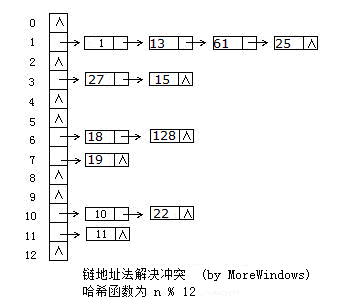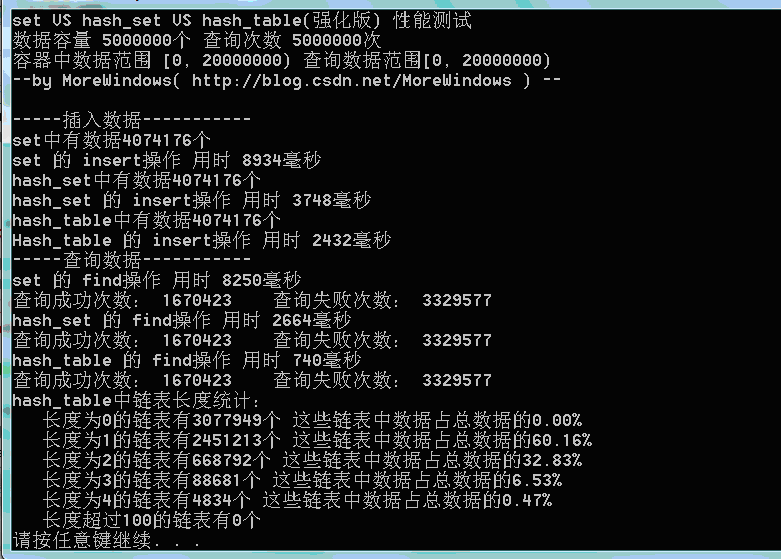STL系列之九 探索hash set
Title: STL系列之九 探索hash_set
Author: MoreWindows
Blog: http://blog.csdn.net/MoreWindows
E-mail: [email protected]
KeyWord: C++ STL set hash_set 雜湊表 鏈地址法
本文將著重探索hash_set比set快速高效的原因,閱讀本文前,推薦先閱讀本文的姊妹篇《STL系列之六 set與hash_set》
一.hash_set之基石——雜湊表
hash_set的底層資料結構是雜湊表,因此要深入瞭解hash_set,必須先分析雜湊表。雜湊表是根據關鍵碼值(Key-Value)而直接進行訪問的資料結構,它用雜湊函式處理資料得到關鍵碼值,關鍵碼值對應表中一個特定位置再由應該位置來訪問記錄,這樣可以在時間複雜性度為O(1)內訪問到資料。但是很有可能出現多個數據經雜湊函式處理後得到同一個關鍵碼——這就產生了衝突,解決衝突的方法也有很多,各大資料結構教材及考研輔導書上都會介紹大把方法。這裡採用最方便最有效的一種——鏈地址法,當有衝突發生時將具同一關鍵碼的資料組成一個連結串列。下圖展示了鏈地址法的使用:

二.簡化版的hash_table
按照上面的分析和圖示,並參考《程式設計珠璣》第15章中雜湊表的實現,不難寫出一個簡單的雜湊表,我們稱之為簡化版hash_table。該雜湊表由一個指標陣列組成,陣列中每個元素都是連結串列的表頭指標,程式分為hash_table.h,hash_table.cpp和main.cpp。
1.hash_table.h
#pragma once
#define NULL 0
//簡化版hash_table
//by MoreWindows( http://blog.csdn.net/MoreWindows )
struct 2.hash_table.cpp
//簡化版hash_table
//by MoreWindows( http://blog.csdn.net/MoreWindows )
#include "hash_table.h"
#include <malloc.h>
#include <memory.h>
hash_table::hash_table(const int ntablesize)
{
m_nTableSize = ntablesize;
m_ppTable = (Node**)malloc(sizeof(Node*) * m_nTableSize);
if (m_ppTable == NULL)
return ;
m_nTableDataCount = 0;
memset(m_ppTable, 0, sizeof(Node*) * m_nTableSize);
}
hash_table::~hash_table()
{
free(m_ppTable);
m_ppTable = NULL;
m_nTableDataCount = 0;
m_nTableSize = 0;
}
int inline hash_table::HashFun(int n)
{
return (n ^ 0xdeadbeef) % m_nTableSize;
}
int hash_table::size()
{
return m_nTableDataCount;
}
bool hash_table::insert(int n)
{
int key = HashFun(n);
//在該連結串列中查詢該數是否已經存在
for (Node *p = m_ppTable[key]; p != NULL; p = p->next)
if (p->val == n)
return true;
//在連結串列的頭部插入
Node *pNode = new Node(n);
if (pNode == NULL)
return false;
pNode->next = m_ppTable[key];
m_ppTable[key] = pNode;
m_nTableDataCount++;
return true;
}
bool hash_table::find(int n)
{
int key = HashFun(n);
for (Node *pNode = m_ppTable[key]; pNode != NULL; pNode = pNode->next)
if (pNode->val == n)
return true;
return false;
}
void hash_table::insert(int *pFirst, int *pLast)
{
for (int *p = pFirst; p != pLast; p++)
this->insert(*p);
}3.main.cpp
在main.cpp中,對set、hash_set、簡化版hash_table作一個性能測試,測試環境為Win7+VS2008的Release設定(下同)。
//測試set,hash_set及簡化版hash_table
// by MoreWindows( http://blog.csdn.net/MoreWindows )
#include <set>
#include <hash_set>
#include "hash_table.h"
#include <iostream>
#include <ctime>
#include <cstdio>
#include <cstdlib>
using namespace std;
using namespace stdext; //hash_set
void PrintfContainerElapseTime(char *pszContainerName, char *pszOperator, long lElapsetime)
{
printf("%s 的 %s操作 用時 %d毫秒\n", pszContainerName, pszOperator, lElapsetime);
}
// MAXN個數據 MAXQUERY次查詢
const int MAXN = 5000000, MAXQUERY = 5000000;
int a[MAXN], query[MAXQUERY];
int main()
{
printf("set VS hash_set VS hash_table(簡化版) 效能測試\n");
printf("資料容量 %d個 查詢次數 %d次\n", MAXN, MAXQUERY);
const int MAXNUM = MAXN * 4;
const int MAXQUERYNUM = MAXN * 4;
printf("容器中資料範圍 [0, %d) 查詢資料範圍[0, %d)\n", MAXNUM, MAXQUERYNUM);
printf("--by MoreWindows( http://blog.csdn.net/MoreWindows ) --\n\n");
//隨機生成在[0, MAXNUM)範圍內的MAXN個數
int i;
srand((unsigned int)time(NULL));
for (i = 0; i < MAXN; ++i)
a[i] = (rand() * rand()) % MAXNUM;
//隨機生成在[0, MAXQUERYNUM)範圍內的MAXQUERY個數
srand((unsigned int)time(NULL));
for (i = 0; i < MAXQUERY; ++i)
query[i] = (rand() * rand()) % MAXQUERYNUM;
set<int> nset;
hash_set<int> nhashset;
hash_table nhashtable(MAXN + 123);
clock_t clockBegin, clockEnd;
//insert
printf("-----插入資料-----------\n");
clockBegin = clock();
nset.insert(a, a + MAXN);
clockEnd = clock();
printf("set中有資料%d個\n", nset.size());
PrintfContainerElapseTime("set", "insert", clockEnd - clockBegin);
clockBegin = clock();
nhashset.insert(a, a + MAXN);
clockEnd = clock();
printf("hash_set中有資料%d個\n", nhashset.size());
PrintfContainerElapseTime("hash_set", "insert", clockEnd - clockBegin);
clockBegin = clock();
for (i = 0; i < MAXN; i++)
nhashtable.insert(a[i]);
clockEnd = clock();
printf("hash_table中有資料%d個\n", nhashtable.size());
PrintfContainerElapseTime("Hash_table", "insert", clockEnd - clockBegin);
//find
printf("-----查詢資料-----------\n");
int nFindSucceedCount, nFindFailedCount;
nFindSucceedCount = nFindFailedCount = 0;
clockBegin = clock();
for (i = 0; i < MAXQUERY; ++i)
if (nset.find(query[i]) != nset.end())
++nFindSucceedCount;
else
++nFindFailedCount;
clockEnd = clock();
PrintfContainerElapseTime("set", "find", clockEnd - clockBegin);
printf("查詢成功次數: %d 查詢失敗次數: %d\n", nFindSucceedCount, nFindFailedCount);
nFindSucceedCount = nFindFailedCount = 0;
clockBegin = clock();
for (i = 0; i < MAXQUERY; ++i)
if (nhashset.find(query[i]) != nhashset.end())
++nFindSucceedCount;
else
++nFindFailedCount;
clockEnd = clock();
PrintfContainerElapseTime("hash_set", "find", clockEnd - clockBegin);
printf("查詢成功次數: %d 查詢失敗次數: %d\n", nFindSucceedCount, nFindFailedCount);
nFindSucceedCount = nFindFailedCount = 0;
clockBegin = clock();
for (i = 0; i < MAXQUERY; ++i)
if (nhashtable.find(query[i]))
++nFindSucceedCount;
else
++nFindFailedCount;
clockEnd = clock();
PrintfContainerElapseTime("hash_table", "find", clockEnd - clockBegin);
printf("查詢成功次數: %d 查詢失敗次數: %d\n", nFindSucceedCount, nFindFailedCount);
return 0;
}在資料量為500萬時測試結果如下:

從程式執行結果可以發現,我們自己實現的hash_table(簡化版)在插入和查詢的效率要遠高於set。為了進一步分析,最好能統計hash_table中的各個連結串列的長度情況,這樣可以有效的瞭解平均每次查詢要訪問多少個數據。寫出統計hash_table各連結串列長度的函式如下:
// by MoreWindows( http://blog.csdn.net/MoreWindows )
void StatisticHashTable(hash_table &ht)
{
const int MAXLISTLINE = 100;
int i, a[MAXLISTLINE], nExtendListNum;
nExtendListNum = 0;
memset(a, 0, sizeof(a[0]) * MAXLISTLINE);
for (i = 0; i < ht.m_nTableSize; i++)
{
int sum = 0;
for (Node *p = ht.m_ppTable[i]; p != NULL; p = p->next)
++sum;
if (sum >= MAXLISTLINE)
nExtendListNum++;
else
a[sum]++;
}
printf("hash_table中連結串列長度統計:\n");
for (i = 0; i < MAXLISTLINE; i++)
if (a[i] > 0)
{
printf(" 長度為%d的連結串列有%d個 這些連結串列中資料佔總資料的%.2lf%%\n", i, a[i], (a[i] * i * 100.0) / ht.size());
}
printf(" 長度超過%d的連結串列有%d個\n", MAXLISTLINE, nExtendListNum);
}用此段程式碼得到連結串列長度的統計結果:

可以發現在hash_table中最長的連結串列也只有5個元素,長度為1和長度為2的連結串列中的資料佔全部資料的89%以上。因此絕大數查詢將僅僅訪問雜湊表1次到2次。這樣的查詢效率當然會比set(內部使用紅黑樹——類似於二叉平衡樹)高的多。有了這個圖示,無疑已經可以證明hash_set會比set快速高效了。但hash_set還可以動態的增加表的大小,因此我們再實現一個表大小可增加的hash_table。
三.強化版hash_table
首先來看看VS2008中hash_set是如何實現動態的增加表的大小,hash_set是在hash_set.h中宣告的,在hash_set.h中可以發現hash_set是繼承_Hash類的,hash_set本身並沒有太多的程式碼,只是對_Hash作了進一步的封裝,這種做法在STL中非常常見,如stack棧和queue單向佇列都是以deque雙向佇列作底層資料結構再加一層封裝。
_Hash類的定義和實現都在xhash.h類中,微軟對_Hash類的第一句註釋如下——
hash table -- list with vector of iterators for quick access。
哈哈,這句話說的非常明白。這說明_Hash實際上就是由vector和list組成雜湊表。再閱讀下程式碼可以發現_Hash類增加空間由_Grow()函式完成,當空間不足時就倍增,並且表中原有資料都要重新計算hash值以確定新的位置。
知道了_Hash類是如何運作的,下面就來考慮如何實現強化版的hash_table。當然有二個地方還可以改進:
1._Hash類使用的list為雙向連結串列,但在在雜湊表中使用普通的單鏈表就可以了。因此使用STL中的vector再加入《STL系列之八 slist單鏈表》一文中的slist來實現強化版的hash_table。
2.在空間分配上使用了一個近似於倍增的素數表,最開始取第一個素數,當空間不足時就使用下一個素數。經過實際測試這種效果要比倍增法高效一些。
在這二個改進之上的強化版的hash_table程式碼如下:
//使用vector< slist<T> >為容器的hash_table
// by MoreWindows( http://blog.csdn.net/MoreWindows )
template< class T, class container = vector<slist<T>> >
class hash_table
{
public:
hash_table();
hash_table(const int ntablesize);
~hash_table();
void clear();
bool insert(T &n);
void insert(T *pFirst, T *pLast);
bool erase(T &n);
void resize(int nNewTableSize);
bool find(T &n);
int size();
int HashFun(T &n);
private:
static int findNextPrime(int curPrime);
public:
int m_nDataCount;
int m_nTableSize;
container m_Table;
static const unsigned int m_primes[50];
};
//素數表
template< class T, class container>
const unsigned int hash_table<T, container>::m_primes[50] = {
53, 97, 193, 389, 769, 1453, 3079, 6151, 1289, 24593, 49157, 98317,
196613, 393241, 786433, 1572869, 3145739, 6291469, 12582917,
25165843, 50331653, 100663319, 201326611, -1
};
template< class T, class container>
int inline hash_table<T, container>::HashFun(T &n)
{
return (n ^ 0xdeadbeef) % m_nTableSize;
}
template< class T, class container>
hash_table<T, container>::hash_table()
{
m_nDataCount = 0;
m_nTableSize = m_primes[0];
m_Table.resize(m_nTableSize);
}
template< class T, class container>
hash_table<T, container>::hash_table(const int ntablesize)
{
m_nDataCount = 0;
m_nTableSize = ntablesize;
m_Table.resize(m_nTableSize);
}
template< class T, class container>
hash_table<T, container>::~hash_table()
{
clear();
}
template< class T, class container>
void hash_table<T, container>::clear()
{
for (int i = 0; i < m_nTableSize; i++)
m_Table[i].clear();
m_nDataCount = 0;
}
template< class T, class container>
bool hash_table<T, container>::insert(T &n)
{
int key = HashFun(n);
if (!m_Table[key].find(n))
{
m_nDataCount++;
m_Table[key].push_front(n);
if (m_nDataCount >= m_nTableSize)
resize(findNextPrime(m_nTableSize));
}
return true;
}
template< class T, class container>
bool hash_table<T, container>::erase(T &n)
{
int key = HashFun(n);
if (m_Table[key].remove(n))
{
m_nDataCount--;
return true;
}
else
{
return false;
}
}
template< class T, class container>
void hash_table<T, container>::insert(T *pFirst, T *pLast)
{
for (T *p = pFirst; p != pLast; p++)
this->insert(*p);
}
template< class T, class container>
void hash_table<T, container>::resize(int nNewTableSize)
{
if (nNewTableSize <= m_nTableSize)
return;
int nOldTableSize = m_nTableSize;
m_nTableSize = nNewTableSize;
container tempTable(m_nTableSize); //建立一個更大的表
for (int i = 0; i < nOldTableSize; i++)//將原表中資料重新插入到新表中
{
Node<T> *cur = m_Table[i].m_head;
while (cur != NULL)
{
int key = HashFun(cur->val);
Node<T> *pNext = cur->next;
cur->next = tempTable[key].m_head;
tempTable[key].m_head = cur;
cur = pNext;
}
m_Table[i].m_head = NULL;
}
m_Table.swap(tempTable);
}
template< class T, class container>
int hash_table<T, container>::size()
{
return m_nDataCount;
}
template< class T, class container>
bool hash_table<T, container>::find(T &n)
{
int key = HashFun(n);
return m_Table[key].find(n);
}
//在素數表中找到比當前數大的最小數
template< class T, class container>
int hash_table<T, container>::findNextPrime(int curPrime)
{
unsigned int *pStart = (unsigned int *)m_primes;
while (*pStart <= curPrime)
++pStart;
return *pStart;
}下面再對set、hash_set、強化版hash_table的效能測試:
測試結果一(資料量500萬):

測試結果二(資料量1千萬):

測試結果三(資料量1千萬):

可以看出,由於強化版hash_table的雜湊表在增加表空間大小時會花費額外的一些時間,所以插入資料的用時與STL提供的hash_set用時相差不多了。但查詢還是比hash_set要快的一些。
四.結語
從簡化版到強化版的hash_table,我們不僅知道了hash_set底層資料結構——雜湊表的運作機制,還知道了如何實現大小動態變化的雜湊表。達到了本文讓讀者瞭解hash_set快速高效的原因。當然本文所給hash_table距真正的hash_set還有不小的距離,有興趣的讀者可以進一步改進。
此外,本文所示範的雜湊表也與最近流行的NoSql資料庫頗有淵源, NoSql資料庫也是通過Key-Value方式來訪問資料的(訪問資料的方式上非常類似雜湊表),其查詢效率與傳統的資料庫相比也正如本文中hast_set與set的比較。正因為NoSql資料庫在基礎資料結構上的天然優勢,所以它完全可以支援海量資料的查詢修改且對操作效能要求很高場合如微博等。
轉載請標明出處,原文地址:http://blog.csdn.net/morewindows/article/details/7330323
再分享一下我老師大神的人工智慧教程吧。零基礎!通俗易懂!風趣幽默!希望你也加入到我們人工智慧的隊伍中來!https://www.cnblogs.com/captainbed
